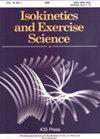神经-前庭-眼部运动和肌筋膜释放对患有慢性踝关节不稳定的足球运动员的本体感觉和表现的影响
IF 0.7
4区 医学
Q4 ENGINEERING, BIOMEDICAL
引用次数: 0
摘要
背景和目的:足球运动员经常使用快速变向、突然加速和爆发性动作。因此,慢性踝关节不稳定是影响这一运动员群体的最常见疾病之一。本研究调查了神经-前庭-眼球运动和肌筋膜松解对患有慢性踝关节不稳定的足球运动员本体感觉和运动表现的影响。材料与方法:这项随机对照临床试验包括 60 名 18-30 岁的足球运动员。球员被随机分为两组。第一组(NVOEG,n=30)参加神经前庭-眼部运动训练计划,第二组(MRHOG,n=30)进行肌筋膜松解训练。两个方案均持续八周。干预前后对参与者的坎伯兰踝关节不稳定性工具(CAIT)评分进行了评估。通过关节位置感测试对运动感觉进行评估。此外,还采用了踢腿速度(KS)、30 米冲刺、之字形敏捷性测试(ZAT)和着地误差评分系统(LESS)测试来评估他们的表现。结果:康复后的得分显示,两组的本体感觉和表现参数与康复前的得分相比均有显著差异。(P<0.05)。在不稳定和稳定踝关节 CAIT、不稳定踝关节本体感觉、LESS、带球 ZAT 性能和 30 米冲刺测试等测试后得分方面,NVOEG 组和 MRHOG 组之间存在显著差异。结论:在对足球运动员进行慢性踝关节不稳定治疗时,神经-瓣膜-眼运动训练方案在本体感觉和表现参数方面效果更佳。本文章由计算机程序翻译,如有差异,请以英文原文为准。
The effects of neuro-vestibular-ocular exercises and myofascial release on proprioception and performance in football players with chronic ankle instability
BACKGROUND AND PURPOSE: Football players often use quick change of direction, sudden acceleration and explosive movements. This is why chronic ankle instability is one of the most common conditions affecting this athlete population. This study investigates the effects of neuro-vestibular-ocular exercises and myofascial release on proprioception and performance in football players with chronic ankle instability. MATERIALS AND METHODS: This randomized controlled clinical trial included 60 football players aged 18–30. The players were randomly divided into two groups. The first group (NVOEG, n=30) was included in the Neuro-Vestibular-ocular exercise training program, while the myofascial release was applied to the second group (MRHOG, n=30). Both protocols were applied for eight weeks. The participants’ Cumberland Ankle Instability Tool (CAIT) scores were assessed before and after the intervention. Proprioception was evaluated by using the joint position sense test. Additionally, kick speed (KS), 30-m sprint, zig-zag agility test (ZAT) and Landing error score system (LESS) tests were applied to evaluate their performance. RESULTS: Post-rehabilitation scores showed significant differences in proprioception and performance parameters compared to pre-scores in both groups. (p<0.05). Significant differences were observed between the NVOEG and MRHOG in the post-test scores, including CAIT for unstable and stable ankle, proprioception for unstable ankle, LESS, ZAT with ball performance, and 30-meter sprint test. CONCLUSIONS: The neuro-vulvular-ocular exercise training protocol had superior results in terms of proprioception and performance parameters in chronic ankle instability management for football players.
求助全文
通过发布文献求助,成功后即可免费获取论文全文。
去求助
来源期刊

Isokinetics and Exercise Science
医学-工程:生物医学
CiteScore
1.20
自引率
14.30%
发文量
37
审稿时长
>12 weeks
期刊介绍:
Isokinetics and Exercise Science (IES) is an international journal devoted to the study of theoretical and applied aspects of human muscle performance. Since isokinetic dynamometry constitutes the major tool in this area, the journal takes a particular interest in exploring the considerable potential of this technology.
IES publishes studies associated with the methodology of muscle performance especially with respect to the issues of reproducibility and validity of testing, description of normal and pathological mechanical parameters which are derivable from muscle testing, applications in basic research topics such as motor learning paradigms and electromyography. The journal also publishes studies on applications in clinical settings and technical aspects of the various measurement systems employed in human muscle performance research.
The journal welcomes submissions in the form of research papers, reviews, case studies and technical reports from professionals in the fields of sports medicine, orthopaedic and neurological rehabilitation and exercise physiology.
 求助内容:
求助内容: 应助结果提醒方式:
应助结果提醒方式:


